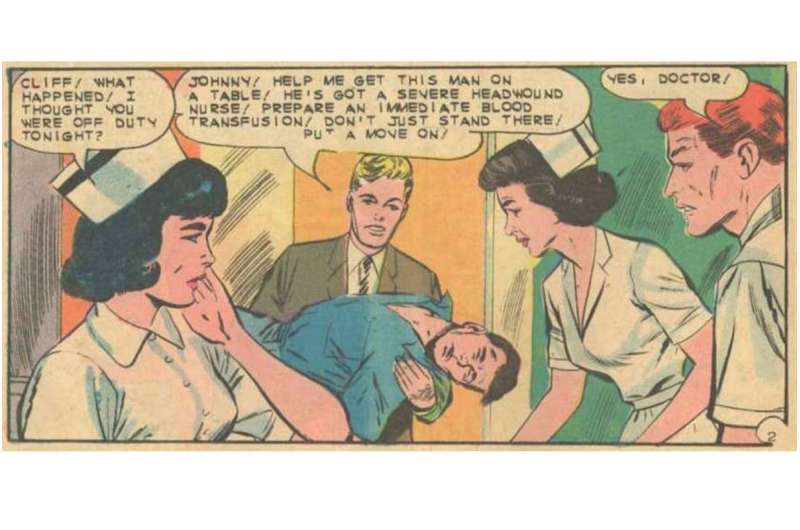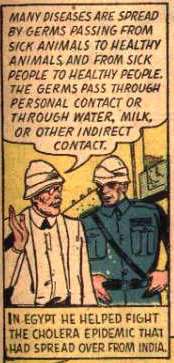Portrayals of doctors in comics have become more realistic, nuanced

The images of doctors found in comics can be comforting, such as the authoritative and compassionate "Rex Morgan, M.D.," or bizarre, as in the case of Marvel Comics character Dr. Strange, a neurosurgeon turned sorcerer.
Their depiction in comics has progressed from slapstick portrayals in the early 20th century to comics that present more realistic representations of them and of the ethical questions they face. Carol Tilley, a professor of information sciences at the University of Illinois, wrote about the representations of doctors and medical practice in comic strips, comic books and graphic novels in the February issue of the AMA Journal of Ethics. The issue was devoted to the topic of graphic medicine.
An increasing number of comics today deal with subjects such as chronic illnesses and patient experiences, as well as education about medical issues, said Tilley, a comics historian and scholar who served as a judge for the Eisner Comic Industry Awards in 2016.
"The way comics have portrayed doctors has changed from cartoony and stereotypical to more nuanced," Tilley said.
The earliest depictions of doctors portrayed them as "a bit quackish," although knowledgable and competent in diagnosis and treatment, Tilley wrote in the journal article. In a surrealist fantasy newspaper comic strip, "Dream of the Rarebit Fiend," that ran from 1904-11, the doctors are encountered only in strange dreams.
Beginning in the 1930s and continuing for many decades, doctors (nearly always male in the comics) were portrayed as benevolent, knowledgeable and authoritative – men of technical and ethical perfection. The comic strip "Rex Morgan, M.D.," created by a psychiatrist, is an example of "the valorization of medicine and scientific expertise," Tilley said.
Nonfiction comics portrayed real-life doctors in much the same way, including a story about Nobel laureate Robert Koch and his discovery of the microorganisms that cause anthrax and cholera, Tilley wrote.
In the early 1940s, nonfiction medical comics addressed health care issues. For example, comics aimed at servicemen addressed the prevention of venereal disease and malaria, and others provided information about mental health issues.

Doctors appear frequently in superhero comics and their medical backgrounds and practice are treated superficially. Tilley wrote about "Dr. Mid-Nite," a comic strip in which a doctor loses his sight in a lab explosion but discovers he can see in the dark and becomes a crime fighter.
Likewise, Marvel Comics' Dr. Stephen Strange "transformed from human to superhero because of an accident," Tilley wrote, but the comic features no real medical storyline or realistic representation of the profession. Instead, "the emphasis is most decidedly on 'strange' rather than 'doctor.'"
Doctors are as likely to appear in superhero comics as villains – think Dr. Decibel of the Institute of Evil or Dr. Tramma, who cybernetically alters humans for evil – as they are as forces of good, Tilley said.
Since the 1970s, Tilley wrote, "the depictions of physicians in contemporary nonsuperhero comics veer toward portraying them as messy and fallible humans with imperfect medical knowledge."
In the past 10 years, comics have taken a realistic look at doctor-patient interactions and at the practice of medicine. "The Bad Doctor," written by a British doctor, tells about a rural Welsh physician who has an obsessive-compulsive disorder, as does one of his patients. The journal Annals of Internal Medicine runs comics written by doctors that depict their everyday lives in the profession.
Nonfiction comics are continuing to be used for education. The public health department serving Seattle's King County has released comics to raise awareness of free clinic services as well as helping people understand pandemics. A pediatric allergist, Alex Thomas, created a comic series called "Iggy and The Inhalers" to help children understand asthma, its triggers and how medicine works to treat it.
The medical profession now is using art forms as an opportunity for expression and reflection on what it means to be a doctor, Tilley said.
"One of the changes we see in more contemporary comics, particularly those created as part of the graphic medicine movement, is a look inside diagnoses, diagnostic procedures, the questions physicians might have in whether they are doing the right thing, the way they connect or don't connect with patients, the doubts they may have about their own expertise or their limits," Tilley said.
However, she said, doctors are still portrayed mostly as white males, and most often as surgeons. As with comics generally, there is a need for greater ethnic, racial and gender diversity, as well as more diversity of specialties within the health care profession to ensure that everyone's stories are told, Tilley said.
More information:
Of Cornopleezeepi and Party Poopers: A Brief History of Physicians in Comics. AMA Journal of Ethics. February 2018, Volume 20, Number 2: 188-194.
DOI: 10.1001/journalofethics.2018.20.02.mhst1-1802.
Journal information: Annals of Internal Medicine
Provided by University of Illinois at Urbana-Champaign


















